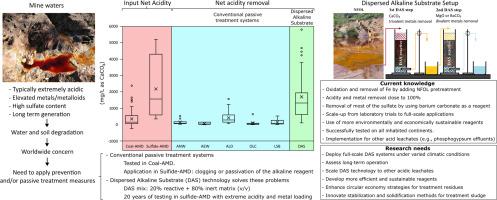高污染酸性矿山废水分散碱性基质被动处理技术:20年成功应用
IF 12.4
1区 环境科学与生态学
Q1 ENGINEERING, ENVIRONMENTAL
引用次数: 0
摘要
在过去的二十年里,分散碱性基质技术(DAS)已经成为一种高效的被动方法,用于处理极端酸性和金属负载的酸性矿山废水。通过将碱性材料(如石灰石、氧化镁、碳酸钡或工业副产品)混合到惰性木屑基质中,DAS系统保持高孔隙率和中和能力,而不会迅速堵塞。该处理技术已经从实验室试验发展到中试和全面的现场测试,使用多步骤系统与天然铁氧化泻湖(NFOL)相结合进行预氧化,证明了其在酸性和金属去除方面的长期有效性。通过寻找新的试剂(例如用于去除二价金属的MgO,用于去除硫酸盐的BaCO₃,用于降低成本的木灰或富含方解石的废物),改进了该工艺的可持续性和适用性。在不同地区——从伊比利亚黄铁矿带到南非、加拿大、南美、亚洲、欧洲和大洋洲——进行的实地试验报告称,净酸去除率通常超过95%,并且几乎完全保留了Al、Cu、Zn、Pb和as等金属(类金属)。矿物学分析表明,污染物主要以氢氧化物、氧氢氧化物和硫酸盐(例如,许氏锰矿、玄武岩、重晶石)的形式沉淀,从而允许富金属污泥的定向增值。剩下的挑战包括评估试剂在不同水文条件下的长期使用寿命,将磷石膏和其他工业渗滤液的全面使用范围扩大到磷石膏和其他工业渗滤液,以及制定残留物稳定和资源回收战略。这篇综述的目的是综合这些发展,评估目前的性能,并确定未来的研究需求,以推进被动DAS处理技术。本文章由计算机程序翻译,如有差异,请以英文原文为准。

Dispersed Alkaline Substrate passive treatment technology for highly contaminated acid mine drainage: 20 years of successful application
Over the past two decades, Dispersed Alkaline Substrate technology (DAS) has emerged as a highly effective passive approach to treating acid mine drainage with extreme acidity and metal loading. By mixing alkaline materials - such as limestone, magnesia, barium carbonate or industrial by-products - into an inert wood-chip matrix, DAS systems maintain high porosity and neutralization capacity without rapidly clogging. This treatment technology has evolved from laboratory trials to pilot and full-scale field testing, using multi-step systems integrated with Natural Fe-Oxidizing Lagoons (NFOL) for pre-oxidation, which have demonstrated their long-term effectiveness for acidity and metal removal. The sustainability and applicability of the process has been improved by the search for new reagents (e.g. MgO for divalent metals removal, BaCO₃ for sulfate removal, wood ash or calcite-rich waste for cost reduction). Field trials in diverse regions - from the Iberian pyrite belt to South Africa, Canada, South America, Asia, Europe and Oceania - report net acid removal often exceeding 95% and near complete retention of metal(loid)s such as Al, Cu, Zn, Pb and As. Mineralogical analyses indicate that contaminants precipitate primarily as hydroxides, oxyhydroxides, and sulfates (e.g., schwertmannite, basaluminite, barite), allowing targeted valorization of metal-rich sludges. Remaining challenges include assessing long-term reagent life under variable hydrological conditions, extending full-scale use to phosphogypsum and other industrial leachates, and developing strategies for residue stabilization and resource recovery. The aim of this review is to synthesise these developments, assess current performance and identify future research needs for the advancement of passive DAS treatment technology.
求助全文
通过发布文献求助,成功后即可免费获取论文全文。
去求助
来源期刊

Water Research
环境科学-工程:环境
CiteScore
20.80
自引率
9.40%
发文量
1307
审稿时长
38 days
期刊介绍:
Water Research, along with its open access companion journal Water Research X, serves as a platform for publishing original research papers covering various aspects of the science and technology related to the anthropogenic water cycle, water quality, and its management worldwide. The audience targeted by the journal comprises biologists, chemical engineers, chemists, civil engineers, environmental engineers, limnologists, and microbiologists. The scope of the journal include:
•Treatment processes for water and wastewaters (municipal, agricultural, industrial, and on-site treatment), including resource recovery and residuals management;
•Urban hydrology including sewer systems, stormwater management, and green infrastructure;
•Drinking water treatment and distribution;
•Potable and non-potable water reuse;
•Sanitation, public health, and risk assessment;
•Anaerobic digestion, solid and hazardous waste management, including source characterization and the effects and control of leachates and gaseous emissions;
•Contaminants (chemical, microbial, anthropogenic particles such as nanoparticles or microplastics) and related water quality sensing, monitoring, fate, and assessment;
•Anthropogenic impacts on inland, tidal, coastal and urban waters, focusing on surface and ground waters, and point and non-point sources of pollution;
•Environmental restoration, linked to surface water, groundwater and groundwater remediation;
•Analysis of the interfaces between sediments and water, and between water and atmosphere, focusing specifically on anthropogenic impacts;
•Mathematical modelling, systems analysis, machine learning, and beneficial use of big data related to the anthropogenic water cycle;
•Socio-economic, policy, and regulations studies.
 求助内容:
求助内容: 应助结果提醒方式:
应助结果提醒方式:


